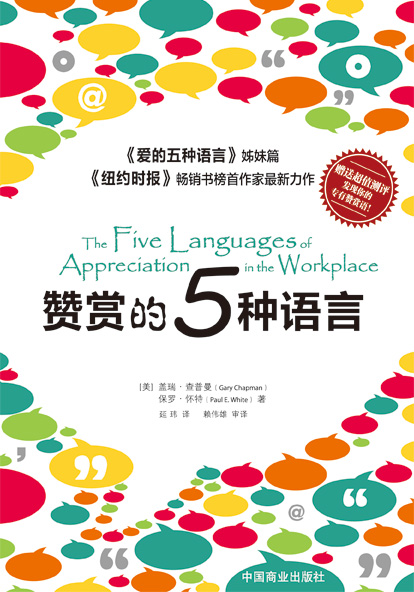The Five Languages of Appreciation in the Workplace
Gary Chapman / Paul White
Price: ¥28.00
ISBN: 978-7-5044-7535-0
Paper: 14.5 X 21
Pages: 172
Category: Communication
Take the MBA Inventory and discover your language of appreciation:
http://www.mbainventory.com/china
 Empowering Organizations by Encouraging People
Empowering Organizations by Encouraging People
About the Authors
 Dr. Gary Chapman, PhD, is the author of the #1 New York Times bestselling The 5 Love Languages. With over 30 years of counseling experience, he has the uncanny ability to hold a mirror up to human behavior, showing readers not just where they go wrong, but also how to grow and move forward. Dr. Chapman holds BA and MA degrees in anthropology from Wheaton College and Wake Forest University, respectively, MRE and PhD degrees from Southwestern Baptist Theological Seminary, and has completed postgraduate work at the University of North Carolina and Duke University.
Dr. Gary Chapman, PhD, is the author of the #1 New York Times bestselling The 5 Love Languages. With over 30 years of counseling experience, he has the uncanny ability to hold a mirror up to human behavior, showing readers not just where they go wrong, but also how to grow and move forward. Dr. Chapman holds BA and MA degrees in anthropology from Wheaton College and Wake Forest University, respectively, MRE and PhD degrees from Southwestern Baptist Theological Seminary, and has completed postgraduate work at the University of North Carolina and Duke University.
About the Authors
 Dr. Paul White, PhD, is a licensed psychologist who has worked with individuals, businesses and families in a variety of settings for over 20 years. He received his B.A. from Wheaton, his Masters from Arizona State, and his PhD in Counseling Psychology from Georgia State University. He consults with successful businesses and high net worth families, dealing with the relational issues intertwined with business and financial wealth. In addition to serving businesses, families and organizations across the U.S., Dr. White has also spoken and consulted in Europe, Central Asia, the Caribbean, and South America.
Dr. Paul White, PhD, is a licensed psychologist who has worked with individuals, businesses and families in a variety of settings for over 20 years. He received his B.A. from Wheaton, his Masters from Arizona State, and his PhD in Counseling Psychology from Georgia State University. He consults with successful businesses and high net worth families, dealing with the relational issues intertwined with business and financial wealth. In addition to serving businesses, families and organizations across the U.S., Dr. White has also spoken and consulted in Europe, Central Asia, the Caribbean, and South America.
Information
The Five Languages of Appreciation in the Workplace: Empowering Organizations by Encouraging People, by Gary Chapman and Paul White, applies the love language concept to the workplace. This book helps supervisors and managers effectively communicate appreciation and encouragement to their employees, resulting in higher levels of job satisfaction, healthier relationships between managers and employees, and decreased cases of burnout. Ideal for both the profit and non-profit sectors, the principles presented in this book have a proven history of success in businesses, schools, medical offices, churches, and industry. Each book contains an access code for the reader to take a comprehensive online MBA Inventory (Motivating By Appreciation) .
The inventory is designed to provide a clearer picture of an individual’s primary language of appreciation and motivation as experienced in a work-related setting. It identifies individuals’ preference in the languages of appreciation. Understanding an individual’s primary and secondary languages of appreciation can assist managers and supervisors in communicating effectively to their team members.
From the Back Cover:
Is appreciation communicated regularly at your workplace?
Do you truly feel valued by those with whom you work?
If you express appreciation in ways that aren’t meaningful to your co-workers, they may not feel valued at all. The problem is you’re speaking different languages. In The 5 Languages of Appreciation in the Workplace, Dr. Gary Chapman and Dr. Paul White will help you:
- Express genuine appreciation to co-workers and staff – even on a tight budget.
- Increase loyalty with the employees and volunteers in your organization.
- Reduce cynicism and create a more positive work environment.
- Improve your ability to show appreciation for difficult colleagues.
- Individualize your expressions of appreciation by speaking the right language.
- Convey the language of physical touch in appropriate ways.
Based on the #1 New York Times bestseller, The 5 Love Languages?, Dr. Chapman and Dr. White give you practical steps to make any workplace environment more encouraging and productive. Before you know it, you will learn to speak and understand the unique languages of appreciation and feel truly valued in return.
Other titles by Gary Chapman:







Reviews
There are no reviews yet.